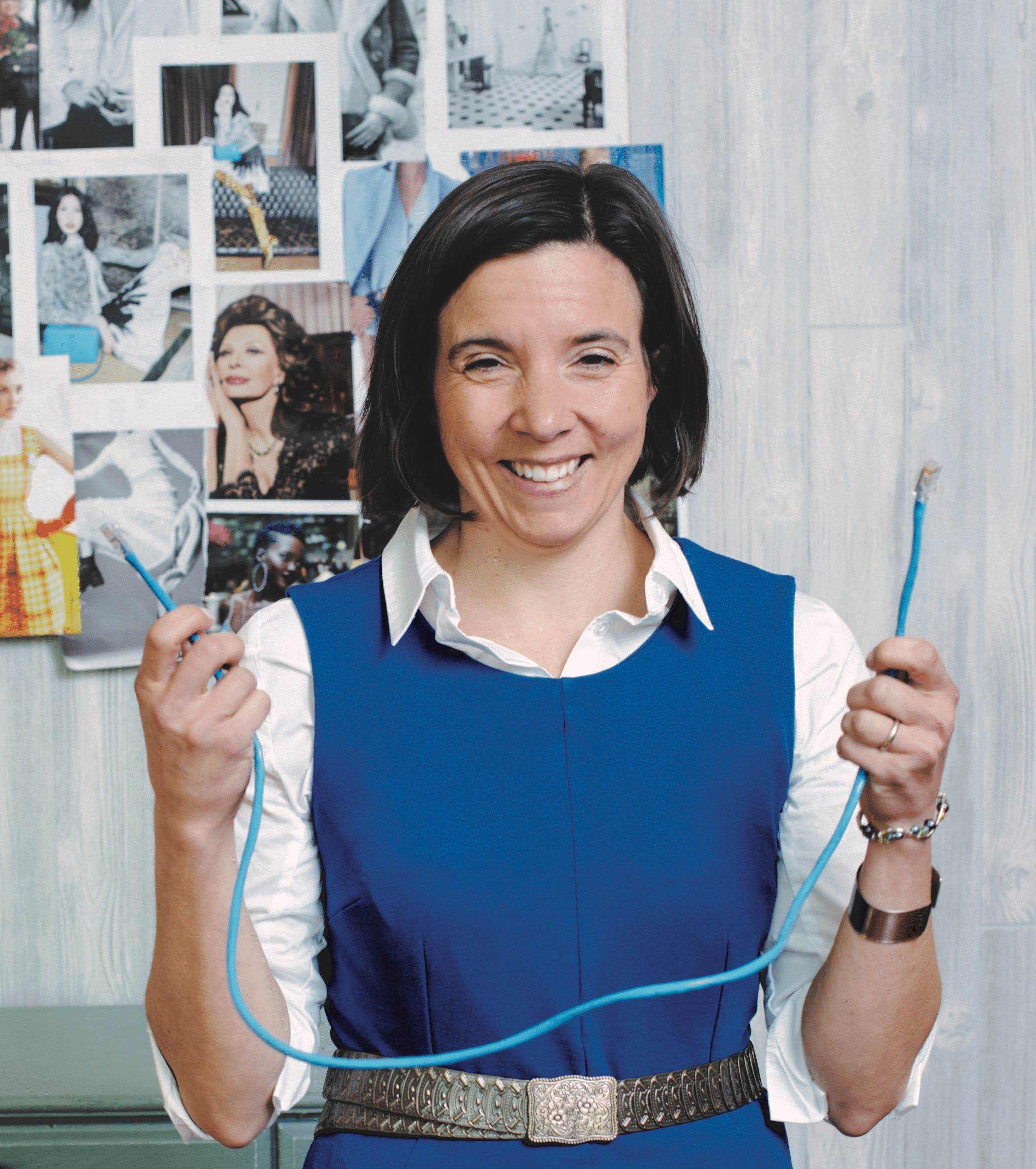Wisconsin broadband director Alyssa Kenney acknowledges that leading a state broadband office might not be for everyone. But when she sat down for a recent interview with Telecompetitor she described the job as exactly what she is looking for because it’s “challenging, exciting and feeds my need to be constantly learning. I’m reading 100 pages a day and as a bit of a bookworm, I love it.”
As Wisconsin’s State Broadband and Digital Equity Director, Kenney leads a team of 22 professionals in the state’s broadband office, which will be responsible for awarding $1.06 billion in rural broadband deployment funding.
Almost apologetic for the size of the office, which is housed inside of Wisconsin’s Public Service Commission (PSC), she explained that the office is responsible for a lot of things, including Capital Projects Fund (CPF) grants, state broadband funding, the Digital Equity Act program, the state universal service fund, telecommunication regulations and wholesale interconnection agreements.
“We are a big team, but the team working on BEAD is a leaner group,” she said.
The office, located in the state capital of Madison, is hybrid in-person and remote. Its parent commission provides any support services needed, mitigating the need for consultant support.
“I work with a phenomenal team… they’re all so smart and committed. And working for the commission ensures we have the resources we need at our disposal,” said Kenney.
Wisconsin Broadband
Kenney describes Wisconsin as a broadband-friendly state. The office was established in 2014 with an initial $500,000 investment. When Kenney arrived in 2019, the state had a budget of $24 million for the year to run the office and to award to providers for broadband deployments.
More recently, the state made an additional $125 million available for broadband, which has been supplemented by federal funding from the Treasury Capital Projects Fund (CPF). Some CPF funds went to broadband buildouts, and some went to device and affordability programs and community centers. Some are still pending.
“Since the broadband office opened, the state has funded 434 broadband projects, with more than 200 still in progress today,” said Kenney.
All of these past projects, Kenney explained, have served to essentially prepare the skilled workforce that will be required as the BEAD projects roll out. “Our [state’s] workforce is ready,” she said.
Also boding well for BEAD in Wisconsin is that previous funding programs have received plenty of applications — so many that funding requested has in some cases far exceeded funding available.
Kenney explained that while state broadband funding is on hold until BEAD is completed, she’s thrilled with the Wisconsin legislature to date. The legislature generally has been very involved in state broadband programs; with BEAD it is looking to ease the permitting process, she said.
A Challenging Start
The initial BEAD challenge process netted 16,000 challenges. Currently, Wisconsin’s BEAD-eligible locations are approximately 123,000 unserved and 115,000 underserved, totaling approximately 238,000 locations. The challenge process may bump that up to around 250,000 locations. Wisconsin is scheduled to have its final determination announced in early August.
Wisconsin’s $1.06 billion BEAD allotment is roughly two-thirds of what Michigan received to reach the same number of people. But Kenney isn’t bitter; she recognizes that factors such as a sandy soil base make burying fiber in her state less challenging than it may be for other states.
Both Michigan and Wisconsin face RDOF defaults from Charter that will now need to be addressed by BEAD. In Wisconsin, 11,000 locations were defaulted on day two of the initial BEAD challenge process. Kenney lamented that this is “…a real number and I am sure they defaulted on the higher cost and difficult-to-reach locations. It’s a big swing, but we will figure it out.”
Getting Ready
Volume two of Wisconsin’s BEAD initial proposal is in the curing process and while Kenney isn’t slow-walking approval, she’d prefer that approval come sometime shortly after the challenge process. “We have to get [volume two] right to make sure BEAD goes smoothly and that broadband gets to where it’s needed,” said Kenney.
While waiting for approval, which she guesses will occur in late summer, Kenney and her staff will require future applicants to submit what she described as a “rigorous letter of intent, a smidge like the FCC long form for RDOF.”
Kenney’s team will review letters of intent (LOIs) to determine whether each applicant is suitable to be invited to participate before being invited. She describes the LOI as one that will include a lot of due diligence to make sure applicants have the fiscal, managerial and technical expertise, as well as the capacity to achieve what they plan to bid on.
“Simply put,” said Kenney, “we might not think you have the capacity that you think you do. We don’t want someone to overbid and not be able to deliver.”
The state plans to define between 1,000 and 2,000 project areas. Kenney equates them to “little LEGOs” that can be combined into a single bid or bid on individually.
“We are a pretty data-savvy office: we’ll break out project units using network design, brownfield and greenfield locations, road networks, jurisdictions, etc.,” Kenney said.
Round by Round
Wisconsin’s BEAD award process will begin with one very big, all-inclusive round similar to Louisiana’s that will allow all reliable technologies. If a network operator is the only applicant for a project area and meets all scoring and cost model criteria for a priority project, the operator will get a preliminary “unofficial” approval subject to NTIA’s approval of Wisconsin’s final proposal. The project must be below the extremely high-cost threshold.
In round 2, new applications will only be accepted for areas that didn’t receive bids in round 1. The state will look at project areas that received more than one bid in round 1 and will ask for applicants’ best and lowest offer, with funding awarded to the eligible applicant that can “make BEAD dollars go as far as possible” and represents “the best project to promote universal service,” Kenney said.
Also in round 2, the state will assess whether awardees in the first or second round should expand or contract their service territories as a condition of receiving funds.
Round 3 will be a “cleanup” round that finds solutions for areas that did not previously receive bids. Kenney anticipates that the PSC might not receive any bids for the state’s granite cliffs and cranberry bogs. (See an Ocean Spray commercial for a visual.)
And finally, to reach universal access in Wisconsin, Kenney said that round 4 will turn to low earth orbit (LEO) satellites and other creative solutions.
“It is going to be a stretch and take more than just BEAD funding, but I feel great about the prospects of achieving universal access in Wisconsin. I can tell you that the Commission will make sure that awardees fulfill their promises,” said Kenney.
She anticipates that initial construction for BEAD projects will begin in early 2026.
The Great Enabler
Originally from Vermont, Kenney relocated to Madison to attend the University of Wisconsin. Following graduation, she immediately entered the world of nonprofits and community centers.
She’s both a big believer and well-versed in digital while having substantial grant experience and the ability to navigate bureaucracy. But what comes across most when you spend a little time with Kenney is her passion. “I love this job — it’s fun, exciting and just challenging enough that I need to be constantly learning,” she said.
While by no means a tech enthusiast, she sees broadband as a key and direct influencer to a lot of the things that interest her, exclaiming that “…economic development, equal education, democracy, literacy, civic participation, sense of belonging are all things that I care about deeply … and good broadband is a prerequisite to all of this.”
“This has become a different, bigger job, but I love it. It’s exactly what you want work to be,” said Kenney. “To be part of something that can be the foundation of so many great things, connecting people better and faster is exciting.”



